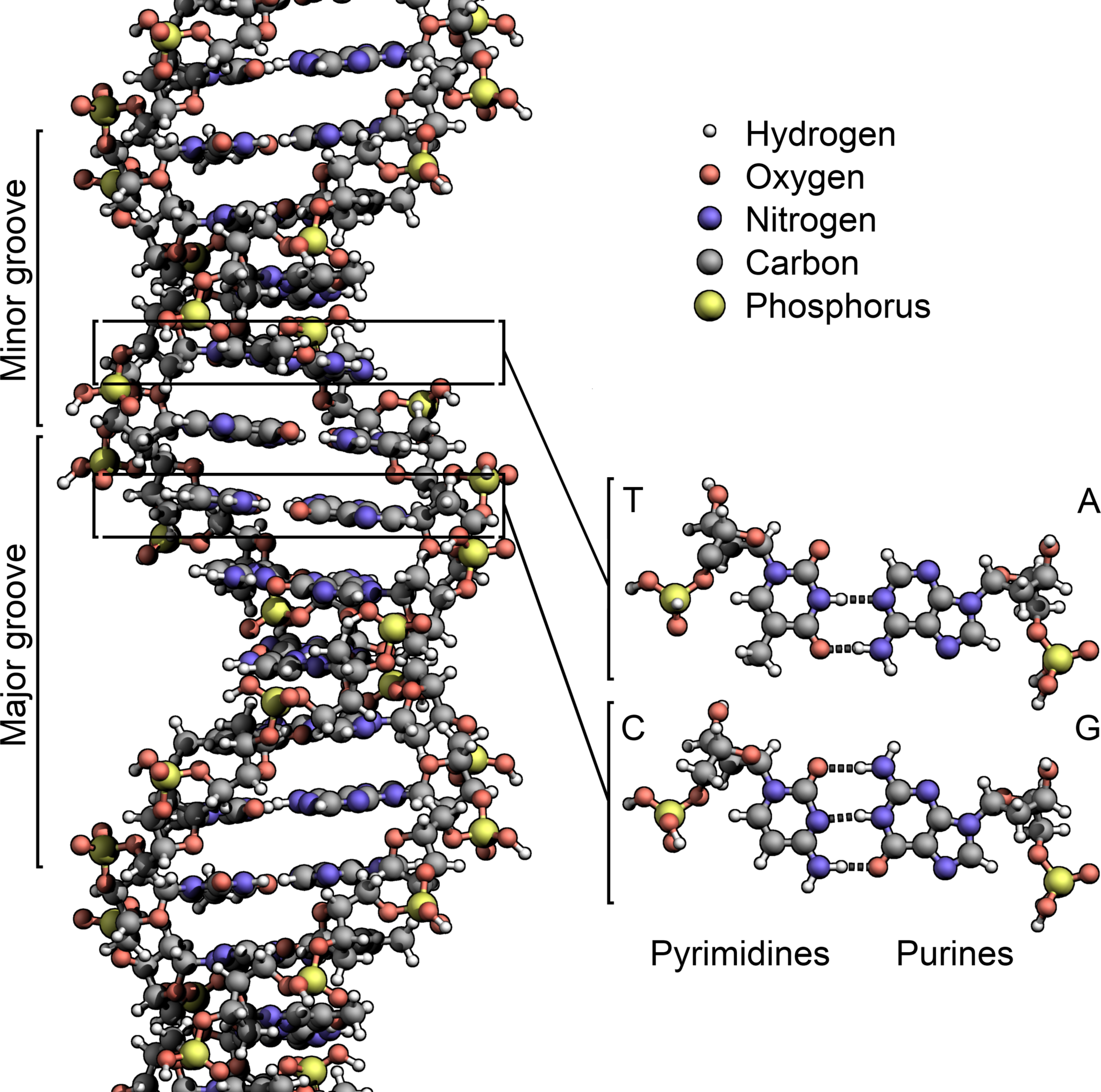

In other words, adenine and thymine are complementary base pairs, and cytosine and guanine are also complementary base pairs. Base-pairing takes place between a purine and pyrimidine: namely, A pairs with T, and G pairs with C. Watson and Crick proposed that the DNA is made up of two strands that are twisted around each other to form a right-handed helix, called a double helix. In its natural state, each DNA molecule is actually composed of two single strands held together along their length with hydrogen bonds between the bases. The phosphate group is attached to the 5' carbon of one nucleotide and the 3' carbon of the next nucleotide. The carbon atoms of the five-carbon sugar are numbered clockwise from the oxygen as 1', 2', 3', 4', and 5' (1' is read as “one prime”). The sugar–phosphate groups line up in a “backbone” for each single strand of DNA, and the nucleotide bases stick out from this backbone. The phosphate group of one nucleotide bonds covalently with the sugar molecule of the next nucleotide, and so on, forming a long polymer of nucleotide monomers. (b) Cytosine and thymine are pyrimidines. In 1962, James Watson, Francis Crick, and Maurice Wilkins were awarded the Nobel Prize in Medicine for their work in determining the structure of DNA.įigure 9.3 (a) Each DNA nucleotide is made up of a sugar, a phosphate group, and a base. This meant they were always paired in some way. Chargaff had shown that of the four kinds of monomers (nucleotides) present in a DNA molecule, two types were always present in equal amounts and the remaining two types were also always present in equal amounts. Watson and Crick also had key pieces of information available from other researchers such as Chargaff’s rules. Watson and Crick were able to piece together the puzzle of the DNA molecule using Franklin's data ( Figure 9.2). In Wilkins’ lab, researcher Rosalind Franklin was using X-ray crystallography to understand the structure of DNA. The patterns give important information about the structure of the molecule of interest. X-ray crystallography is a method for investigating molecular structure by observing the patterns formed by X-rays shot through a crystal of the substance. Pauling had discovered the secondary structure of proteins using X-ray crystallography. Other scientists, such as Linus Pauling and Maurice Wilkins, were also actively exploring this field. In the 1950s, Francis Crick and James Watson worked together at the University of Cambridge, England, to determine the structure of DNA. Describe how eukaryotic and prokaryotic DNA is arranged in the cell.Learn more about DNA and the genome with Dr Alex Lathbridge.Learning Objectives By the end of this section, you will be able to: These strong bonds form a sugar-phosphate backbone. These basic units are linked together to form strands by strong covalent bonds between the deoxyribose sugar of one nucleotide and the phosphate of the next nucleotide. This means they always pair in the same way: A with T, T with A, C with G and G with C. The nucleotides are identical except for the base, which can be an adenine (A), thymine (T), guanine (G) or cytosine (C).īases are complementary. These nucleotides consist of a deoxyribose sugar, phosphate and base. The basic units (monomers) of DNA are nucleotides. A gene is the unit of heredity, and may be copied and passed on to the next generation. Each gene codes for a particular sequence of amino acids in order to make a specific protein. GenesĪ gene is a small section of DNA in a chromosome. These are long threads of DNA, which are made up of many genes. DNA can be cut up and separated, which can form a 'bar code' that is different from one person to the next. This is why people can be identified using DNA fingerprinting. Įxcept for identical twins, each person's DNA is unique. It carries the genetic code, which determines the characteristics of a living organism. DNA is a polymer - a large and complex molecule, made from many small monomers It is made up of two strands forming a twisted ladder structure called a double helix. The genetic material in the nucleus of a cell is composed of a chemical called DNA.


 0 kommentar(er)
0 kommentar(er)
